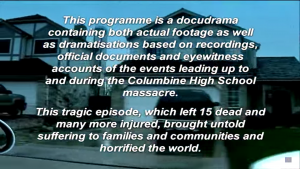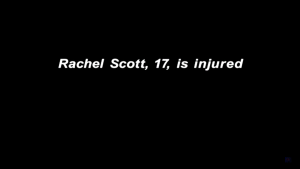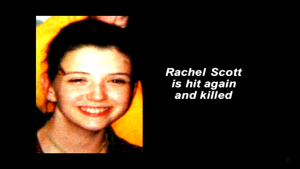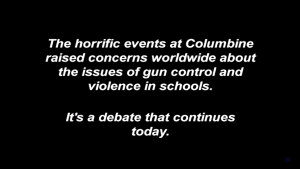Reflection:
In the paper below, I used all the concepts of rhetoric described throughout the semester. This paper was challenging because I had to put into my own words how the documentary Zero Hour: Columbine used Terministic Screens, Ethos, Logos, and Pathos to convey their message. The documentary itself was hard to watch, but it provided lots of details and useful knowledge for our Common Good Project. Through this paper, I was able to learn how to write using rhetorical knowledge. School shootings are a well-talked about topic that ties into a much bigger issue. It is important to learn about people’s perspectives on it to fully understand the issue. The use of images from the documentary was very effective because it added value to the rhetorical devices used.
Introduction
“Zero Hour” is a documentary series in the UK and Canada that has been on television since 2004 (Zero Hour). It shows the moments leading up to and during an event before it is considered a part of history (Zero Hour). For this paper, the episode that is used is entitled, “Zero Hour Columbine”. In this documentary, it shows every action, in detail, that took place at Columbine High School. In addition, it shows the thoughts of Eric Harris and Dylan Klebold (the shooters) before and during the event. The massacre that was the Columbine shooting took place on April 20, 1999 from 11:08am to 12:08pm. Eric and Dylan committed premeditated murder on a large portion of the student body at Columbine High School and ended the event by committing suicide through self-inflicted gunshots to the head. This 46-minute documentary shows the step-by-step actions taken place during the planning and execution stages of Eric and Dylan’s plan by using ethos, logos, pathos, and terministic screens.
Method
By using ethos, logos, pathos, and terministic screens to describe this event, it helps the audience better understand the reality and severity of the situation. In addition, these implications allow the audience to understand the full story. The Columbine shooting was a horrific event that should have never taken place and using this rhetoric will give others the knowledge of what signs to notice and how to properly go about dealing with them.
Ethos
Ethos, in rhetorical terms, is applying ethics into a situation to seem more credible to the audience. The television program “Zero Hour” seems as if it is a trusted source and depicts
 Figure 1
Figure 1
accurate information, as it has been on air since 2004 and is still making new episodes this year. Shown above in Figure 1 is the disclaimer shown at the very beginning of the documentary to show the credibility of the program and clips in it. The first scene depicted in the documentary is of the actor playing Eric Harris with the actor’s voice quoting what Eric Harris said in his journal in 1998. This adds credibility to the documentary because it is a written statement by Eric stating exactly what he planned to do on April 20, 1999. Having the actor read it instead of the narrator puts the situation in more context and makes the audience feel more connected to the events that are about to transpire. From there on, they show a collection of home videos, written statements read by the actors playing Eric Harris and Dylan Klebold, and dramatizations. In addition to those, they also include eyewitness testimonies from those who were students during the time of the murders. The testimonies are in their own words, and the documentary provides dramatizations of the moments they describe. Each testimony takes place at a different time and place, so the audience can understand the full story with decreased bias from the students. For example, one testimony is from a student named Brooks Brown. He describes Eric and his relationship by saying him and Eric had altercations in the past. These altercations become so severe that Eric posted on his website that he was going to kill Brooks. The incident was reported to the police; however, they did not have proper documentation to do anything about it, so the report was dropped. He goes on to explain that in the months proceeding the post and before the massacre, they worked out their problems and were on better terms. On the day of the event, Eric missed a big test in the class they had together—Eric was very strict with his grades so missing a test or class was a very big deal—and Brooks confronted him about it when he saw him moments before the shootings started. Eric told him that it did not matter and to go home because he did not bother him as much anymore.
Logos
Logos, in rhetorical terms, uses logical reasoning to persuade an audience. This documentary does this right away by showing the disclaimer (Figure 1). It states that 15 students died, and many were injured that day due to an act of gun violence. Throughout it, whenever a student is injured or killed, a black screen is shown with their name, age, and whether the person was killed or injured. If they were killed, it also includes a picture of that student. Shown below in Figures 2 and 3 are examples of what the screens look like. Rachel


Figure 2 Figure 3
Scott was the first student to be shot and injured; she was shot again and killed seconds after being wounded. This type of remembrance is done for each student affected by Eric and Dylan. Another way logos is used in the documentary is when the show gives the exact hour, minute, and second of each action. For example, the time the pipe bombs placed in the cafeteria by Eric and Dylan were set to detonate at exactly 11:25am, and the audience knows this by looking at the time stamp on the screen. In addition, when they talk about a past event, they give the date at the bottom of the screen to show exactly when the event took place in time. The testimonies given by the students and Brooks’ parents are an example of logos as well as ethos.
Pathos
Pathos, in rhetorical terms, appeals to emotion. The events that transpired on April 20, 1999 were awful and emotional for both the families of the victims and the rest of the world. The documentary is supposed to raise awareness and heighten emotions about how serious this event was. When talking about the events, the narrator uses words such as “horrific” and “tragedy” to describe it.
 Figure 4
Figure 4
To prove this, the last thing shown before the credits is in Figure 4. It uses the word “horrific” to describe the event and states gun control is still an issue to this day in order to appeal to the audience’s emotions. The dramatizations seem almost real and add to the reality of the event. They show scenes of students and teachers dying and the physical pain of each person affected. In all, it is almost hard to watch as these events take place. This appeals to the emotions of the audience to make them feel what the people there felt.
Terministic Screens
This documentary could be considered a terministic screen because it is seen as informative as well as bringing awareness to how serious of an issue school shootings are. Though the narrator only tells of what happened, the eye-witness reports are worded to make the audience think about how awful the event was. Mentioned in the Ethos section, Brooks and Eric had an altercation that led Eric to threaten Brooks’ life on his website, and the police was notified. Brooks’ father mentions, “if [the police] had acted on these claims, Eric would’ve been in jail…and Columbine never should’ve happened” (K54Gaming). This puts the thought in the audience’s mind that the police should have done more, and that Columbine was easily preventable. Following the discussion of this in the documentary, the narrator mentions that this was not the first time Eric Harris was on the police’s radar. In Littleton, Colorado on January 30, 1998, Eric and Dylan broke into a van and stole electrical equipment (K54Gaming). They were eventually arrested for felony charges on the grounds of criminal trespass and theft. They were both ordered to go to Anger Management classes; these classes were supposed to help them learn how to deal with their anger. Though they both seemed “cured” by the end of the classes, they were not. Unfortunately, these classes only made them angrier. This following testimonies by the actors who play Eric and Dylan lead to the audience to believe that this incident may have been the first trigger for the shooting. An exert stated by Dylan says that his revenge will be “God-like” and mentions the Commons—assuming this means the cafeteria where the first pipe bombs were set to detonate. Through these examples, the audience is led to believe that Columbine should have been stopped and that there were many warning signs that were ignored.
Conclusion
Said repeatedly throughout the documentary is the statement, “this never should have happened”. If the police had had proper documentation to follow through with the threat on Brooks Brown’s life, Eric Harris would have faced serious charges. If just one person reached out to Eric or Dylan and tried to be their friend, the boys would have had a better outlook on life and their peers. Just one these acts could have prevented this massacre from happening, but nothing was done. This documentary has given details of the events that took place before and during the massacre as well as testimonies from students and Brooks Brown’s parents. What the audience should take from this is to reach out to their peers or children and make sure they are doing okay. Any simple act of kindness could have prevented the Columbine shooting, and any simple act of kindness could prevent another shooting from happening in the future.
Works Cited
K54Gaming, and Zero Hour. “Zero Hour Columbine HD.” YouTube, YouTube, 27 Jan. 2019.
“Zero Hour.” IMDb, IMDb.com, 11 June 2010.
